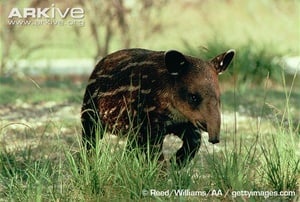A list of my favorite images of tapirs.
List #2 may be viewed here: www.listal.com/list/favorite-images-tapirs-2
en.wikipedia.org/wiki/Tapir
A tapir is a large herbivorous mammal, similar in shape to a pig, with a short, prehensile snout. Tapirs inhabit jungle and forest regions of South America, Central America and Southeast Asia.
The five extant species of tapirs are the Brazilian tapir, the Malayan tapir, the Baird's tapir, the kabomani tapir and the mountain tapir.
The four species that have been evaluated (the Brazilian, Malayan, Baird's and mountain tapir) have all been classified as endangered or vulnerable. Their closest relatives are the other odd-toed ungulates, including horses and rhinoceroses.
Size varies between types, but most tapirs are about 2 m (7 ft) long, stand about 1 m (3 ft) high at the shoulder, and weigh between 150 and 300 kg (330 and 700 lb). Their coats are short and range in color from reddish-brown to grey to nearly black, with the notable exceptions of the Malayan tapir, which has a white, saddle-shaped marking on its back, and the mountain tapir, which has longer, woolly fur.
All tapirs have oval, white-tipped ears, rounded, protruding rumps with stubby tails and splayed, hooved toes, with four toes on the front feet and three on the hind feet, which help them to walk on muddy and soft ground. Baby tapirs of all types have striped-and-spotted coats for camouflage.
The proboscis of the tapir is a highly flexible structure, able to move in all directions, allowing the animals to grab foliage that would otherwise be out of reach.
Tapirs often exhibit the flehmen response, a posture in which they raise their snouts and show their teeth to detect scents. This response is frequently exhibited by bulls sniffing for signs of other males or females in oestrus in the area. The length of the proboscis varies among species; Malayan tapirs have the longest snouts and Brazilian tapirs have the shortest.
The evolution of tapir proboscises, made up almost entirely of soft tissues rather than bony internal structures, gives the Tapiridae skull a unique form in comparison to other perissodactyls, with a larger sagittal crest, orbits positioned more rostrally, a posteriorly telescoped cranium, and a more elongated and retracted nasoincisive incisure.
 Login
Login








































